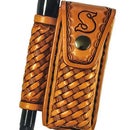Introduction: Arduino Chemistry Probe Kit - Temperature and Conductivity
A Chemistry teacher I work with wanted to let his students build a sensor kit to test for conductivity and temperature. We pulled a few different projects and resources and I combined them into one project. We combined an LCD Project, Conductivity Probe, and Temperature Sensor Probe.
Pictured is the final product.
Step 1: Supplies
You will need:
- Arduino Uno (I used the Sparkfun Inventors Kit)
- Breadboard
- Jumper Wires
- Alligator Clip Wires
- 10K Ohm Resisters (x2)
- LCD Display
- Temperature Sensor (DS18B20)
- Conductivity Probe (DIY Version in Step 6)
- Electrical Tape
- Soldering Iron
- Solder
- Wire Cutter/Stripper
- Pliers
Step 2: Wiring Diagram
To make a plan that students could follow, I got to learn how to make a wiring diagram. I used the software called Fritzing.
Step 3: Build the LCD Circuit
Conceptually I split this into 3 parts; the LCD, Temp Sensor, and Conductivity Probe.
I built the LCD Circuit by following the instruction in the Sparkfun Inventor's Kit Guide: Circuit #15. I'm not going to attempt to type out all the pin connections (study the circuit diagram).
Mods to the original design:
- I shifted the LCD to the top end of the breadboard so that I could conserve space on the bottom end of the board.
- I rotated the blue trimpot 180* and swapped the Positive and Negative wires to match.
After the wiring was complete, I uploaded a basic LCD test sketch.
From time immemorial, all first coding programs should be "HELLO WORLD."
Step 4: Prep the Temp Sensor
The stock photo shows the original bare wires. The are too short in the original configuration.
Steps to make usable ends:
- Strip the black sheath an extra inch or two
- Strip the individual wires to expose 0.5 inch of copper
- Tin the bare copper so they can be inserted into the breadboard
Step 5: Wire the Temp Sensor
The temp sensor has 3 wires
- Red = Vcc (Positive)
- Black = Ground (Negative)
- White = Signal
The Red and Black wires go into their respective Positive and Negative rails on the breadboard. The documentation on the temp sensor (on the Sparkfun website) is sparse. But many of the reviews commented that you need a 10K Ohm pull-up resistor. After trial and error I discovered this to be correct. This is also a digital temperature sensor, so it needs to plug into the digital pins on the Arduino.
Wiring the White Wire
- The White sensor wire is plugged into Row 25 on the bread board (any row is fine)
- A 10K Ohm resistor is plugged into Row 25 and the Positive rail (this is the pull-up resistor)
- A White jumper wire is plugged into Row 25 and Digital Pin 7 on the Arduino.
- I tried to keep my signal jumper wires white for simplicity sake, but any color will work
Step 6: DIY Conductivity Probe
I followed the instructions on this example to build a Conductivity Sensor.
Using a piece of nichrome wire (acquired from the chemistry teacher), I cut two equal lengths about 6" long. I bent them as seen in the photos and taped them to a section a Bic pen (leftover from my Perfect Pocket Pen 'ible) with electrical tape. With the loops on the probe wires, I can use alligator clips to connect the probe to the breadboard.
Alternatives:
We tested this conductivity probe concept using "wire" made by unbending paperclips. That gave us similar readings and we will most likely use the paperclips with the students. The paperclip wire will probably corrode much faster, but these are essentially throw-away consumables.
Step 7: Wire the Conductivity Probe
Again we followed these instructions to wire the probe into the breadboard and arduino.
Wire the Probe:
- A RED jumper wire is plugged into the Positive rail
- A RED alligator clip connects this RED wire to one side of the Conductivity Probe
- A 10k Ohm resister is plugged into Row 28 and the Negative rail
- A WHITE jumper wire is plugged into Row 28 and Analog Pin A0 on the Arduino
- A BLACK jumper wire is plugged into Row 28
- A BLACK alligator clip connects this BLACK wire to the other side of the Conductivity Probe
Step 8: Coding
Again, I combined the code from the 3 projects; LCD, Temp, and Conductivity. It's fairly straight forward and the code is commented well. You will need to download and install some extra libraries to make it work. You will need the DallasTemperature and OneWire libraries.














